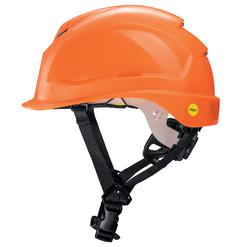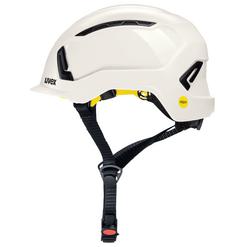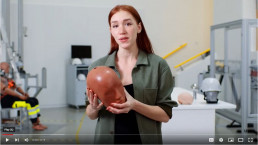Those who work regularly on construction sites are at risk of head injuries. If you work on a construction site, hitting your head is not uncommon. Knocks and bumps are usually minor, but sometimes harder hits can occur.
Accidents at work can include knocks to the head, falling objects, slips, trips, and falls. It is important to ensure adequate helmet safety when working in areas prone to head impacts. Reducing the risk of serious head injuries is possible by taking the necessary safety precautions.
In the fast-paced world of the construction industry, safety is paramount. Yet, despite technological advancements and safety standards, accidents remain prevalent. Head injuries stand out for their potential to result in long-term disabilities or fatalities.
This article delves into workplace accidents that occur, types of head injuries and their real-life consequences. It is reinforced by telling statistics and emphasises the irreplaceable role of helmet safety and personal protective equipment (PPE).
Understanding head injuries
A head injury is a broad term that describes a vast array of injuries that occur to the scalp, skull, brain, and underlying tissue and blood vessels in the head. Traumatic brain injury (TBI) is the term used for Injuries to the brain that are caused by accidents or physical violence.
A TBI can be caused by a bump, blow, or jolt to the head or a hit to the body that causes the head and brain to move rapidly back and forth.
Traumatic Brain Injuries occur on a spectrum, the most common being a mild TBI or concussion. Hitting your head on a cabinet door, falling over, or getting injured playing a sport might cause one of these mild TBIs. The most common type of TBI is a concussion, which accounts for up to 75% of all TBI cases. (1) (2) These injuries are far more common than you think; 50% of TBIs go undiagnosed or undetected, (1) (3) while 90% of diagnosed TBIs do not involve a loss of consciousness. (4)
While you might experience pain and some neurological symptoms from a concussion, a brain scan may not show any findings like bleeding, bruising, or swelling. People with a mild TBI or concussion usually feel better within a few weeks and, in some instances, sooner.
Moderate or severe TBIs, however, will show up on brain scans, usually in various ways. Hematomas, specifically epidural or subdural hematomas, are one way a TBI can manifest. Moderate to severe TBIs can also include contusions, bruising of the brain tissue or haemorrhages when active bleeding is present. TBIs can also progress from one degree to another, which is why it is so important to seek medical care. Some hematomas can occur several days or even weeks following an injury to the head.
Although measures can be taken to evaluate possible head injuries, diagnosing concussions (especially in non-medical settings) is notoriously difficult. Only suitably qualified medical professionals can officially diagnose concussion; a cautious approach should always be taken.
Common work-related accidents can be knocks to the side of the head, falling objects, slips, trips or falls. These can be angled impacts, which can create a rotational motion.
The human brain is amazing but sensitive, especially to rotational motion. Rotational motion results from oblique or angled impacts to the head. Almost all head impacts can generate rotational motion, which can cause strain on the brain tissue, which may lead to concussions or even more serious brain injuries. Dropped objects or striking your head against something, including slips, trips and falls, do not always occur in a linear/straight line motion; some of these impacts are oblique/angled. The moment your head is hit by an object or hits the ground at an angle, it can be forced into rotation in varying degrees, depending on the impacting object or surface. If the rotational motion generated is transferred to the brain, it can cause injury to the brain tissue or the blood vessels connected to the brain.
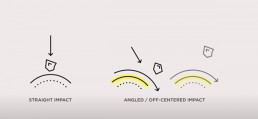
The brain is more sensitive to rotational motion than linear motion because the brain tissue is much weaker in shear than in linear compression. When different parts of the brain move relative to each other due to rotational motion, the tissues can stretch, which can cause concussions or other brain injuries. The brain, which consist mostly of water, and the cerebrospinal fluid fill up most of the skull. As mentioned, water is incompressible, so the brain will not move much from a straight impact. However, most angled impacts introduce a rotational motion to the head. Rotational motion to the head causes the brain to rotate inside the skull. This causes a relative movement between the skull and the brain, which can cause a tear of blood vessels as well as strain in the brain and can cause a TBI.
The real-life consequences of a work-related TBI accident
The aftermath of a work-related accident, particularly one that leads to a head injury, goes beyond immediate physical harm.
Physical Impairment: Severe head injuries can lead to paralysis, loss of sensory functions, or cognitive impairments. Mediate and mild TBI can lead to long term cognitive impairment. This can mean a lifetime of reliance on medical support and rehabilitation.
Mental and Emotional Trauma: The trauma of experiencing an accident can lead to post-traumatic stress disorder (PTSD), depression, or anxiety, affecting the victim’s quality of life and ability to return to work.
Economic Impact: Beyond medical bills, victims might face loss of income due to inability to work, and companies can face legal actions and increased insurance pension premiums.
A study of work-related traumatic brain injuries (wrTBIs) (5) in the construction industry in Sweden and Germany analysed sets of public data on head injuries occurring in the construction industry from the workers’ compensation systems in Sweden and Germany, 2014 – 2018.
The study focuses on workers’ compensation for TBI. It found that TBI accounts for 11–22% of all head injuries and up to 61% for severe cases. It found an incidence of 13 (Sweden) and 117 (Germany) per 100,000 full time workers as compared to 22–212 in North American studies. A limitation of studies based on workers’ compensation claims is that they underestimate the true burden of wrTBI. The most frequent events producing TBI were fall accidents in both countries. The study highlights that safety helmet testing standards should evaluate protection against TBI and skull fractures.
According to the UK Health and Safety Executive (HSE), construction workers are more likely to suffer a concussion than any other type of worker. They are also a costly problem for the construction industry. The HSE estimates that the cost of work-related concussions in construction is £34 million annually. This includes the cost of medical care, lost productivity, and compensation for workers unable to work due to their injuries. (6, 7)
The cost of concussions is not just a financial burden. It is also a human cost. Concussions can cause long-term problems, such as memory loss, difficulty concentrating, and depression. These problems can significantly impact the lives of workers who suffer from them.
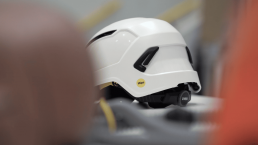
Statistics on Workplace Accidents in Construction and wrTBIs (Work related Traumatic Brain Injuries)
Workplace accidents in the construction industry can occur for many reasons, but some are more common than others. Each year, an estimated 60,000 work-related accidents involving head injuries are reported in Germany. Of these incidents, 1.5 per 1,000 result in a fatality due to the severity of the injury sustained. (8)
A 2021 study by Brolin et al., ‘Work-related traumatic brain injury in the construction industry in Sweden and Germany’ (5), states: “In the German construction industry, an estimated 49,881 work-related head injuries were reported during 2014–2018 of which 10,800 (22%) were work-related TBIs (wrTBI). 254 head injuries reported were fatal, of which 155 (61%) were wrTBI. During the same period, 1,362 new injury pensions were granted of which 545 (40%) were related to wrTBI.
The data shows that approximately 2,200 wrTBI occur annually in Germany and 45 in Sweden. In Sweden, 11% of all work-related head injuries resulted in wrTBI, while in Germany, 22–61% of all work-related head injuries resulted in wrTBI, with higher ratios for increasing severity. The wrTBI incidence was lower in Sweden than in Germany, however, the events leading to injury showed many similar trends. For both countries, falls from a height was the most frequent event leading to severe wrTBI. This issue highlights the importance of fall prevention in the construction industry to monitor and manage risks related to working at heights (i.e., risk analysis, training, and organisational aspects), and the use of safety equipment to prevent falls (i.e, climbing platforms, supported scaffolding, and guardrails) and to mitigate injuries in the case of a fall (i.e., personal fall arrest systems and safety helmets).” (5)
A glimpse into global statistics underscores the gravity of the issue:
International Labor Organization (ILO) estimates yearly show at least 60,000 fatal accidents on construction sites worldwide. This is one fatal accident every ten minutes. One in every six fatal accidents occurs on a construction site, making it one of the most hazardous work sectors. (9)
Head injuries are particularly concerning, as they are responsible for most fatal workplace injuries. They often result from falls from heights, being struck by falling objects, or accidents involving heavy machinery.
The Importance of Helmet Safety and Proper PPE
Recognising the risks, the onus falls on employers and employees to prioritise helmet safety and appropriate PPE. Traditional safety helmets are developed and tested for straight impacts, but studies have shown that the brain is more sensitive to rotational motion (angled impacts) than linear motion (straight impacts). (10) Rotational motion can be dangerous and result in traumatic brain injuries (TBIs). When rotational motion is involved, even impacts that might be considered light can cause concussions due to the brain’s sensitivity.
None of the current tests for today’s helmet standards consider the impact of rotational motion on the wearer’s head. Currently, there is no rotational testing within the industrial helmet standard EN397, but helmet wearers should know that the standard is only the minimum requirement.
Understanding the nuances of angled impacts and rotational injuries is crucial for developing effective protective measures. It underscores the importance of safeguarding against direct impacts and ensuring that helmets and other protective equipment can mitigate the effects of rotational motion. We should work to ensure adequate helmet safety when working in hazardous areas with the risk of head impacts. Taking the necessary safety precautions can help to reduce the risk of serious head injuries.
With a proactive approach towards safety (such as updating your helmet to the latest technology), the frequency and severity of accidents, particularly head injuries, may be reduced. For the worker on-site, a safety helmet is more than just a part of their uniform. It symbolises the industry’s commitment to their wellbeing, a promise that at the end of a hard day’s work, they can return home safely to their loved ones.
VIDEO: uvex x Mips: How the Mips® safety system works
References:
(1) The neuropathology of traumatic brain injury https://www.ncbi.nlm.nih.gov/pmc/articles/PMC4694720/
(2) Translational Research in Traumatic Brain Injury – https://www.ncbi.nlm.nih.gov/books/NBK326730/
(3) American Medical Society for Sports Medicine position statement: concussion in sport https://pubmed.ncbi.nlm.nih.gov/23243113/
(4) Concussion – https://www.ncbi.nlm.nih.gov/books/NBK537017/
(5) Work-related traumatic brain injury in the construction industry in Sweden and Germany – Karin Brolin, Daniel Lanner, Peter Halldin – ScienceDirect https://www.sciencedirect.com/science/article/pii/S0925753520305439
(6) concussion-in-the-workplace-factsheet.pdf (headway.org.uk) (headway.org.uk)
(7) Health and safety in construction (HSG150) (hse.gov.uk) Statistics – Index of tables
(8) https://publikationen.dguv.de/widgets/pdf/download/article/3893
(9) https://www.ilo.org/wcmsp5/groups/public/—dgreports/–dcomm/documents/publication/wcms_067574.pdf
(10) On the subject of brain sensitivity Kleiven 2003, Kleiven 2007 and https://www.ncbi.nlm.nih.gov/pmc/articles/PMC4090913/
